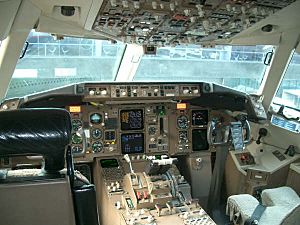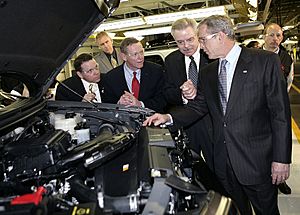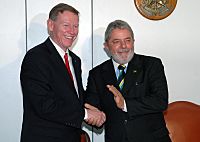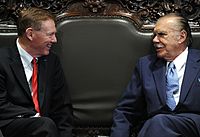Alan Mulally facts for kids
Quick facts for kids
Alan Mulally
|
|
|---|---|

Mulally in 2013
|
|
| Born |
Alan Roger Mulally
August 4, 1945 Oakland, California, U.S.
|
| Alma mater | |
| Known for |
|
| Spouse(s) | Nicki Mulally |
| Children | 5 |
Alan Roger Mulally, born on August 4, 1945, is an American engineer who worked with airplanes and led big companies. He is well-known for being the president and CEO of the Ford Motor Company from 2006 to 2014.
Before joining Ford, he started his career as an engineer at Boeing in 1969. He helped Boeing become strong again against its competitor, Airbus, in the mid-2000s. Mulally is also famous for helping Ford recover during the Great Recession. While other American car companies needed government help, Ford did not, thanks to his leadership. His work at Ford is described in the book American Icon: Alan Mulally and the Fight to Save Ford Motor Company. After leaving Ford, he joined the Board of Directors of Google (now Alphabet) on July 15, 2014, a position he held until 2024.
In 2015, Mulally was honored by being added to the International Air & Space Hall of Fame at the San Diego Air & Space Museum.
Contents
Early Life and Learning
Alan Mulally was born in Oakland, California. His parents, Lauraine and Charles Mulally, met at a USO dance. Alan grew up in Lawrence, Kansas, his mother's hometown. He was a member of the Plymouth Congregational Church. He looked up to Reverend Dale Turner, who he called "a mentor and an inspiration." Mulally often sat at the front of the church to learn how the minister influenced the people. At 17, he was inspired by President John F. Kennedy's challenge to send a person to the moon.
His Education Journey
Mulally went to the University of Kansas, which was also his mother's college. He earned two degrees there: a Bachelor of Science in 1968 and a Master of Science in 1969. Both degrees were in aeronautical and astronautical engineering. He was also part of the Kappa Sigma fraternity. Later, in 1982, he earned a Master's degree in Management (S.M.) from MIT's Sloan School of Management as a Sloan Fellow.
His Career Path
Working at Boeing

Boeing hired Mulally right after he finished college in 1969. He started as an engineer. He worked on many different engineering and program management jobs. He helped with important projects like the Boeing 727, 737, 747, 757, 767, and Boeing 777 airplanes.
He led the team that designed the cockpit for the 757/767 planes. This design was very new because it was the first all-digital cockpit in a commercial aircraft. It also allowed two different planes to be flown by pilots with the same training. Mulally then worked on the 777 program. He started as the director of engineering and later became the vice president and general manager in 1992.
He was later promoted to vice president of Engineering for the commercial airplane group. He was known for promoting the "Working Together" idea, which was important for the 777 program and beyond. In 1994, Mulally became senior vice president of Airplane Development. In this role, he was in charge of all airplane development, flight tests, and getting planes certified. In 1997, Mulally became the president of Boeing Information, Space & Defense Systems. He held this job until 1998 when he became president of Boeing Commercial Airplanes. He also took on the chief executive officer duties in 2001.
Mulally was considered a top choice to become the CEO of the main The Boeing Company after two previous CEOs left. However, he was not chosen for the top job.
For his great work at Boeing, Aviation Week & Space Technology magazine named him "Person of the Year" in 2006.
Leading Ford Motor Company

A former Ford CEO, Donald Petersen, suggested Mulally for the top job at Ford. On September 5, 2006, Mulally became the president and CEO of Ford Motor Company. He took over from Bill Ford, who became the executive chairman.
One of Mulally's first decisions at Ford was to bring back the Taurus car name. He did not understand why the company had stopped making the Taurus, as it had been one of Ford's best-selling cars.
Mulally took charge of Ford's "The Way Forward" plan. This plan aimed to fix Ford's big financial losses and shrinking market share. His efforts to cut costs helped the company make a profit for the first time in two years. Ford also stopped paying dividends to its shareholders for a while.
In 2006, Mulally led Ford to borrow $23.6 billion by using all of Ford's assets as collateral. He said he wanted to use the money to make big changes and to have "a cushion to protect for a recession or other unexpected event." At the time, this loan seemed like a desperate move. However, it is now seen as a smart decision that helped Ford stay financially stable. Unlike its rivals, General Motors and Chrysler, Ford did not need a government loan during the automotive industry crisis of 2008–2009. Mulally even spoke to the United States Congress to support government loans for GM and Chrysler. He explained how important it was for the economy and other car makers if parts suppliers went out of business. In May 2009, Ford chairman William Clay Ford, who hired Mulally, said that "Alan was the right choice [to be CEO], and it gets more right every day."
In 2007, he oversaw the sale of Jaguar Cars and Land Rover to Tata Motors, an Indian car company. Mulally said he had "no regrets" about the sale. He wanted Ford to focus on its main Ford brand. Ford received $2.3 billion from the sale. Mulally also sold off Aston Martin and Volvo Cars, and reduced Ford's ownership in Mazda.
In 2008, as Ford faced more losses during an economic downturn, the company announced a plan. On December 2, 2008, they proposed cutting Mulally's salary to $1 per year if Ford received government loans. During meetings about government loans, he and other leaders were criticized for flying in corporate jets. For a later meeting, he drove a Ford-built hybrid electric vehicle from Detroit to Washington. He also sold all but one of the company's corporate jets.
Because of his achievements at Ford, he was included in the 2009 Time 100 list of the most influential people. The entry, written by Steve Ballmer, said that Mulally "understands the fundamentals of business success as well as any business leader I know."
In 2011, Mulally was named "Person of the Year" by the Financial Times ArcelorMittal Boldness in Business Awards. He was also named the "2011 CEO of the Year" by Chief Executive magazine. In 2011, Mulally also received an Edison Achievement Award for his dedication to new ideas throughout his career.
In 2012, the University of Kansas gave Mulally an honorary Doctor of Science degree. This was for his important contributions to engineering and the transportation industry.
On November 1, 2012, Ford announced that Mulally would stay with the company until at least 2014. He eventually retired on July 1, 2014. Mark Fields took over his role.
After Ford
On July 9, 2014, he joined the Board of Directors of Google (now Alphabet). In April 2016, Mulally became a senior fellow at Seattle University's Albers School of Business.
His Management Style
Mulally worked out four new agreements with the United Automobile Workers union. These agreements helped lower labor costs for Ford.
He lived very close to his office at Ford's main headquarters in Dearborn, Michigan. Every Thursday at 7 a.m., he held a meeting with Ford's executives. This meeting was called a "Business Plan Review" (BPR) and took place in the "Thunderbird Room" at Ford's headquarters. In February 2007, Mulally told a group of 100 information technology staff, "We have been going out of business for 40 years." He repeated this message to other employee groups.
How He Managed Himself
McKinsey & Company asked Mulally how he kept his mental and physical energy high. He replied, "Everyone talks about how you need to manage your time. You need to manage your energy as well. First, you have to ask, 'What gives me energy?' There can be many sources: your family, exercise, your spiritual well-being... In our house, we had a family meeting every week—the family BPR ['Business Plan Review']—where we reviewed what we needed to do and the support required to get us through the week. It is another kind of process step, and a really important one."
Images for kids








